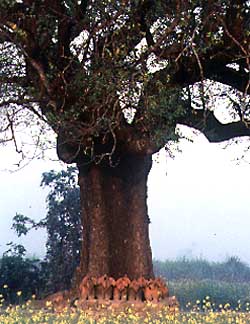|
Chapter 2: Background Information for Teachers |
|
||||||||||||
Above: Kali-Ma shrine in eastern Uttar Pradesh
|
Many shrines in India are outside, with either no external structure or only a small niche or edifice to designate their presence. Often deities are worshiped through natural landmarks, such as mountains, rivers, large rocks, or trees. The streets of most communities are punctuated with many such shrines: a sacred stone grappled by the roots of a banyan tree, a tiny niche tucked into the side of a building, an ancient carving resting on a cement platform at a crossroads. Frequently the deity honored is a goddess who is viewed as the mother of the community and all its affairs. The shrine may not have a full-time priest or caretaker. Instead, members of the community will take turns cleaning and caring for the image, replacing flowers and offerings as part of vows to the goddess in return for her beneficence. | ||||||||||||
|
Case Study: Kali-Ma Shrine Kali-Ma, one of many forms of the Goddess, is viewed in north central India as the Mother Goddess and is petitioned for aid when any kind of problem strikes a family. Many believe her to be both the cause and the cure of smallpox, cholera, and measles. When stricken with one of these diseases, a person is said to be inhabited by Kali-Ma. Part of the cure is to honor the goddess within. Often the worshiper will promise to give the goddess terra-cotta elephants if she answers his or her prayers. These elephants are believed to become real animals in the spirit world the instant they are placed in the shrine, and many believe that Kali-Ma rides them in her nightly battles against evil. Once the elephants have been given, they are transformed by the goddess and no longer have any value. They are left beneath the tree to crumble and disintegrate, to be replaced when another devotee's prayers are answered. In these photographs of a shrine to the goddess Kali-Ma, the presence of the goddess is announced by three symbols: first, the sacred tree that throughout India indicates a divine presence; second, the small cone (pinda) of sculpted clay representing the goddess Kali-Ma, which is unique to her worship in eastern Uttar Pradesh; and third, the iron trident (trishula) that is the weapon she uses to kill her evil foes. Surrounding these three symbols are terra-cotta elephants given to her during her pujas. | |||||||||||||
